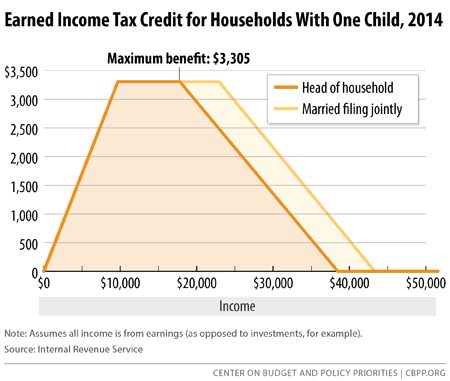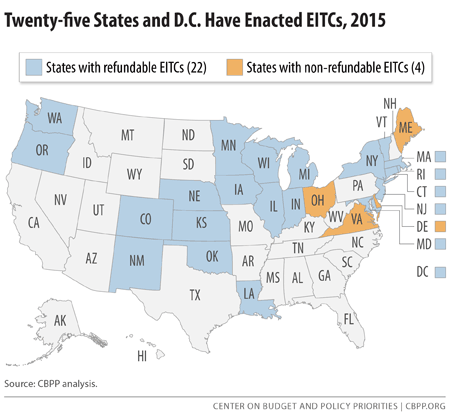States Can Adopt or Expand Earned Income Tax Credits to Build a Stronger Future Economy
PDF of this report (7pp.)
By Erica
Williams and Michael
Leachman
Updated February 18, 2015 - Center on Budget and Policy Priorities
Half of all states plus the District of Columbia have enacted their own
version of the federal Earned Income Tax Credit (EITC) to help working families
earning low wages meet basic needs. State EITCs build on the success of
the federal credit by keeping working parents on the job and families and
children out of poverty. This important state support also extends the
federal EITCfs well-documented long-term positive effects on children, which in
turn boost the nationfs future economic prospects.
State EITCs provide extensive benefits to children, families, and
communities, and are straightforward to administer and to claim. Lawmakers
in states without their own EITC should consider enacting one. States
that have cut back or eliminated their credits should reverse course, and states
that have limited their credits so that they only offset income taxes
should make them fully refundable, which would vastly enhance their impact.
With this important investment, states can make a big difference in the
lives of low- and moderate-income working families.
Why Consider an EITC?
Many children in working families live in poverty — some 9.9 million
poor children in 2013 had at least one working parent.[1] And many families with incomes modestly above the
federal poverty line, currently about $24,000 for a family of four, also have a
hard time affording basic necessities. A full-time job at the minimum
wage is insufficient to keep a family with one working parent out of poverty,
and sluggish wage growth for low-earning families means that many will likely
continue to struggle.
In addition, low- and moderate-income families in almost all states pay
higher state and local taxes as a share of their income than do upper-income
families. This imbalance results from states relying heavily on sales,
excise, and property taxes, all of which fall more heavily on poorer
families. Some states have become even more reliant on these taxes in
recent years, further increasing taxes on working-poor and near-poor
families.
The EITC originated as a federal tax credit for working people and families
with low and moderate incomes that, among other things, rewards work, reduces
poverty, and improves the outlook for low-income children. State
lawmakers can leverage the proven effectiveness of the federal EITC to address
poverty, low wages, and skewed tax systems by implementing a state-level
credit. Just like the federal EITC, state EITCs:
- Help working families make ends meet. Refundable
EITCs provide low-income workers with a needed income boost that can help
them meet basic needs and pay for the very things that allow them to work,
like child care and transportation.
- Keep families working. EITCs help
families that work get by on low wages, which helps them stay employed.
They are also structured to encourage the lowest-earning families to work
more hours. That extra time and experience in the working world can
translate into better opportunities and higher pay over time. Three out
of five filers who receive the federal credit use it just temporarily — for
just one or two years at a time.[2]
- Reduce poverty, especially among
children. The federal EITC is the
nationfs single most effective tool for reducing poverty among working
families and children. It lifted about 6.2 million people — over half
of them children — out of poverty in 2013. State EITCs build on that
record.
- Have a lasting effect. Low-income children in
families that get additional income through programs like the EITC do better
and go farther in school. And children in low-income families that get
an income boost during their early childhood years work more and earn more as
adults. This is good for communities and the economy because it means
more people and families are on solid ground and fewer need help over the
long haul.
More States Leveraging the Federal Credit, But Others Have Fallen Back
In recent years, three states — Colorado (2013), Connecticut (2011), and
Ohio (2013) — have enacted their own versions of the EITC to bolster the
wages of struggling families,[3] and many other states have improved existing credits.
In 2014, Washington, D.C. became the first jurisdiction to expand the
credit for workers without dependent children in the home, extending the
creditfs reach to childless workers with somewhat higher incomes and setting
its value at 100 percent of the federal credit. Also in 2014, Iowa raised
its credit to 15 percent of the federal EITC from 14 percent, Maryland raised
its credit to 28 percent of the federal EITC from 25 percent (scheduled to
phase in over four years), Minnesota increased in the total value of its credit
by 25 percent, Ohio doubled its credit to 10 percent of the federal EITC
(though it remains nonrefundable), and Rhode Island cut its credit to 10
percent of the federal EITC from 25 percent but also made it fully refundable,
expanding the credit for most households. In 2013, Oregon expanded its credit
to 8 percent of the federal EITC from 6 percent, and Iowa doubled its credit to
14 percent of the federal EITC.
In other states, lawmakers have cut back or eliminated this support for
families earning low wages. In 2013, North Carolina lawmakers allowed the
statefs EITC to end after tax year 2013 and cut it by 10 percent in its final
year. In 2011, Michigan cut its credit by 70 percent and Wisconsin cut
its credit by 21 percent for families with two or more children. Prior to
that, in 2010, New Jersey reduced its credit to 20 percent of the federal EITC,
from 25 percent.
Nevertheless, one in three recipients of the federal EITC now lives in a
state with its own EITC, and state EITCs boost the earnings of working families
by about $3 billion annually.
EITC Design Rewards Working Families
The EITC only goes to working families and is designed to reward their
effort. For families with very low earnings, the dollar amount of the
EITC increases as earnings rise, which encourages families to work more hours
when possible. Working families with children earning up to about $39,000
to $52,000 (depending on marital status and the number of children in the
family) generally can qualify for a state EITC, but the largest benefits go to
families with incomes between about $10,000 and $23,000. Workers without
children can also qualify in most states, but only if their income is below
about $15,000 ($20,000 for a married couple), and the benefit is small.
FIGURE 1

The EITCfs design also reflects the reality that larger families face higher
living expenses than smaller families: the maximum benefit varies for families
with one, two, and three or more children. For example, the maximum
federal benefit for families with two children in tax year 2013 is $5,460,
compared to $3,305 for families with one child. (As with most other
federal tax provisions, the IRS adjusts EITC benefit amounts and eligibility
levels each year for inflation.) [4]
Figure 1 shows how the EITC works for a single-mother family with one
child earning the minimum wage in 2014 (about $15,000 a year for full-time,
year-round work). For every dollar she earns, she gets 34 cents in EITC
benefits. The value of the credit continues to increase at that rate
until her earnings reach $9,720. At that point, she receives the maximum
benefit of $3,305. Once her earnings exceed $17,830, the credit shrinks
by about 16 cents for each additional dollar of earnings until reaching zero
(at about $39,000 in earnings).
Most States Model Their EITCs on Federal Credit
Nearly all state EITCs are modeled directly on the federal EITC.
This means that they use federal EITC eligibility rules and offer a state
credit that is a specified percentage of the federal credit. (The
percentages are shown in Table 1.) Minnesota uses federal eligibility
rules, and its credit parallels major elements of the federal structure;
however, it has its own schedule for the income levels at which the credit
phases in and out. Indiana uses old federal guidelines that exclude
recent expansions and improvements to the federal credit. And, Washington,
D.C.fs newly expanded EITC for workers without dependent children will phase in
following federal guidelines, but the maximum credit will extend to 150 percent
of the poverty line (for an individual), and the credit will fully phase out at
twice the poverty line.
FIGURE 2

Twenty-one states and Washington, D.C. follow the federal practice of
offering a fully grefundableh EITC. (See Figure 2.) In other words,
the amount by which the credit exceeds annual income taxes is paid as a refund;
a family with no income tax liability receives the entire EITC as a refund.
Without it, the EITC would fail to offset the other substantial state and local
taxes families pay. Refundability is what makes the EITC so effective at
reducing poverty, because it lets families keep more of what they earn and
helps them keep working despite low wages.
The remaining four states with EITCs — Delaware, Maine, Ohio, and Virginia —
offer non-refundable credits. That means the credits are available only to
the extent that they offset a familyfs state income tax. A non-refundable
EITC can reduce income taxes for families with state income tax
liability, but it does not make up for other taxes that working families
pay. Nor does it do much, if anything, to help keep families working and
out of poverty. Ohiofs EITC is limited even further, to no more than half
of income taxes owed on taxable income above $20,000.
TABLE 1

